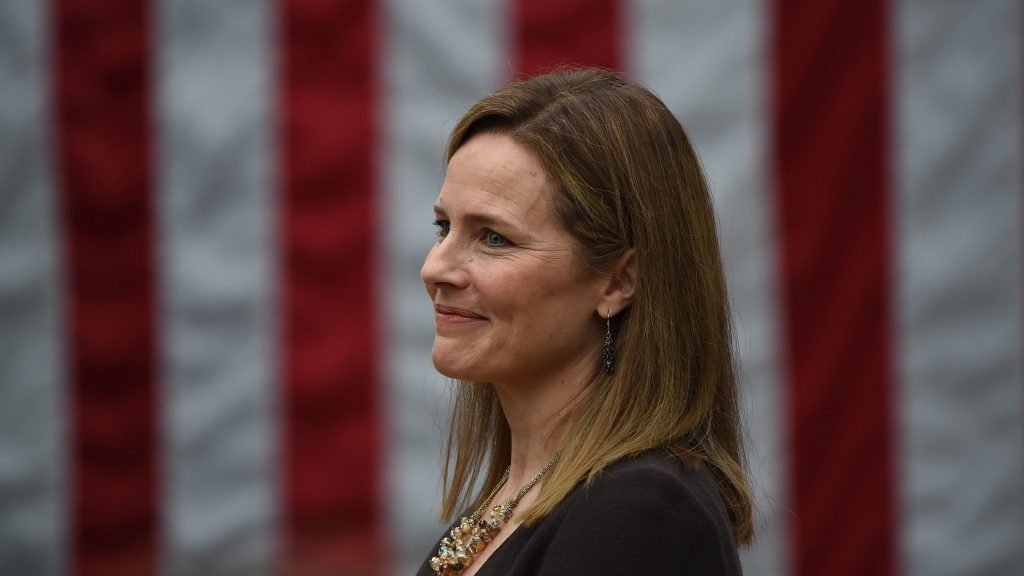WHO IS AMY CONEY BARRETT, AND WHAT HAS SHE DONE SO FAR ON THE SUPREME COURT?

On Oct. 27, 2020, Amy Coney Barrett was sworn in as an associate justice of the U.S. Supreme Court, capping a process that proved more partisan than any in recent history.
Barrett’s seating marked the first time in 150 years that a Supreme Court nominee was confirmed with unanimous opposition from the Senate minority party. The third justice appointed by President Donald Trump, she filled the vacancy left by the death of Ruth Bader Ginsburg, who had served in the Court since the Clinton administration.
The debate over her confirmation was notably tense and partisan in character. Though similar to the debate over the confirmation of Trump’s most recent prior Court appointee, Brett Kavanaugh, the Republicans’ firm hold on the Senate made opposition to her appointment largely symbolic.
The vast majority of Senate Republicans who cast votes had initially held in February 2016, entering the final year of the Obama administration, that a president shouldn’t appoint a new justices during an election year. But just six-and-half weeks ahead of the Nov. 3 election this time, Republicans seemingly reversed their position when they argued that it is the Senate’s duty to confirm nominations – be it an election year, or not. This evident change in was generally labeled as hypocritical by Senate Democrats, who argued that the Republicans set a precedent in 2016 that they were not honoring. Some others labeled it as a simple power grab, a means to secure a solid 6-3 conservative majority in the Court before Democrats could again control the White House and/or Senate.
One clip that went viral online shortly after the Supreme Court vacancy arose with the death of Justice Antonin Scalia was of Sen. Lindsey Graham, R-S.C., in a hearing during 2016 declaring, “I want you to use my words against me. If there’s a Republican president in 2016 and a vacancy occurs in the last year of the first term, you can say Lindsey Graham said let’s let the next president, whoever it might be, make that nomination.”Despite this statement, Graham was quick to support Barrett’s confirmation in late 2020. He defended his support of Trump’s speedy nomination in a Tweet made the day after Ginsburg died: https://twitter.com/LindseyGrahamSC/status/1307381862504042497?s=20
The Senate voted to confirm Barrett’s appointment on Oct. 25, with 54 votes for, 48 against, and 1 member absent (Kamala Harris, D-Calif.). Only one Republican voted against Barrett, Susan Collins of Maine. This is largely believed to be due to Collins’
Democrat competitor being within striking distance of defeating the incumbent, with Maine’s population generally opposing the confirmation.
Prior to her Supreme Court nomination, Barrett was a professor of law at the Notre Dame Law School, from 2014-17, before Trump appointed her to the Seventh Circuit Court of Appeals in 2017. She was considered among one of the mostly likely candidates for him to choose for his next Supreme Court appointment, an honor that went to Kavanaugh, instead.
She has been known for her consistently conservative record on ruling in cases when she served in the 7th Circuit Court, 2017-20, in Indiana. One particular concern that dissenting voices have is her anti-abortion stance and her openness to the reversal of Roe v. Wade, a case which she does not consider a legal super-precedent. With the strong conservative tilt in the Supreme Court, the possibility for Roe v. Wade’s reversal appears to be at an all-time high.
Barrett subscribes to a school of constitutional interpretation called originalism. Originalism is the belief that the meaning of the Constitution is based on the intentions of the designers of the Constitution (this also includes the writers of the Amendments), rather than being a living document. Though some liberals have been known to be originalists, this school of interpretation is largely favored by conservatives. This is often contrasted with judicial activism, in which judges interpret laws in the context of what implications a court ruling would have for present-day society, rather than rely chiefly on the original meaning.
Since her elevation to the Supreme Court, Barrett has voted in one high-profile case. In Roman Catholic Diocese of Brooklyn v. Cuomo (2020), Barrett joined the majority in favor of the Diocese of Brooklyn, with an outcome of 5-4. New York Gov. Andrew Chris Cuomo had earlier issued an executive order placing a 25-person occupancy limit on religious services, in an attempt to diminish the spread of COVID-19. The Court ruled on Nov. 25, striking down Cuomo’s order. By some observers, she is speculated to have had a major role in writing the majority opinion, based on its writing style allegedly resembling her own.

Leave a comment